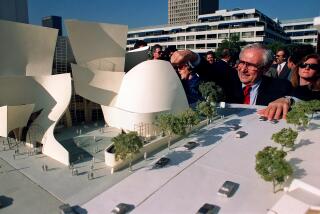He Set America Singing
- Share via
Everyone knows Woody Guthrie as the writer of such group sings as “This Land IsYour Land” and “So Long, It’s Been Good to Know You,” but through the years his image has turned into a bin of cliches: Dust Bowl refugee, migrant farm worker, union activist.
Now, however, with “This Land Is Your Land: The Legacy of Woody Guthrie,” a traveling exhibition from the Smithsonian Institution--the first major exhibit ever on the folk legend--there’s a chance to view the man and the artist in a deeper light. It’s on view at the Autry Museum of Western Heritage in Griffith Park.
Curated by daughter Nora Guthrie (with help from Pete Seeger, Arlo Guthrie and others), the exhibit is culled from memorabilia recovered from the Guthrie home after his death in 1967 and kept by Harold Leventhal, his last manager. Included are photos, film footage, artifacts, notebooks, essays, drawings (Guthrie reveals himself a savvy political cartoonist) and, excitingly, song manuscripts.
“These are things we kids had taken for granted all our lives,” said Nora Guthrie. “But 10 years ago, I walked into Harold’s office and realized we had something.”
Teenagers not familiar with Guthrie will learn of an outspoken visionary who shone a light on one of America’s darkest periods, the Depression, and who continues to have an impact on today’s folk and rock musicians.
*
Chronologically organized, the exhibit lets visitors ramble with Woody from his Oklahoma hometown in 1926 (where family tragedies set him on the highway), through Texas’ Dust Bowl and California’s “Garden of Eden,” and on to New York, where he lived half his life.
The showstopper seems to be the hand-penned manuscript (cross-out marks and all) of “This Land Is Your Land,” originally called “God Blessed America” and written, we’re told, as an angry retort to Irving Berlin’s blithely patriotic “God Bless America.”
At every turn, music--from peers such as Blind Lemon Jefferson, Leadbelly, Cisco Houston, Seeger and Guthrie himself--enhances the exhibit. The period of the 1930s and ‘40s is evoked through blown-up paintings and photos, poems and song lyrics transferred onto canvas scrims.
“The intent was to bring to light the multifaceted aspects of this guy who’s been seen as an American icon just for a couple of songs, like ‘So Long, It’s Been Good to Know You,’ that all schoolkids learn,” Autry curator Michael Fox said. “This is the first exhibit ever on Guthrie, and there’s been so little information out there. We see a side of his personality and a humor we’ve never seen before.”
The exhibit runs through September, but there is something extra planned this weekend. On Saturday, at the museum’s Wells Fargo Theater, a radio drama called “Hard Traveling: An Ear Picture of Woody Guthrie’s Life and Music” will be performed at 4:30 and 7:30 p.m.
Written by Rosemary Alexander, the production features narration in Guthrie’s own words and a host of music from George S. Clinton’s Western Heritage Band, with Rick Cunha (who played with Seeger) illuminating what inspired Guthrie to create his songs.
Despite the drama’s “Hard Traveling” title, however, the exhibit makes clear that Guthrie enjoyed early successes. Soon after hitchhiking to Hollywood in 1937, he secured a spot as a singing radio host, receiving 20,000 letters a week from “farmers, movie workers, town workers, ships at sea, gold prospectors, desert rats, dude ranches, Skid Row tenements and people of all colors.”
In 1938, with actor Will Geer and musician Houston, he toured San Joaquin Valley migrant camps--not to work but to perform agitprop theater, “a turning point in his art.”
Joining Geer in New York City in 1940, he became the toast of the left-leaning cultural scene, lauded by John Steinbeck (who first heard him at a “Grapes of Wrath” benefit). Guthrie played major concerts with Josh White, Leadbelly, Burl Ives, Brownie McGee and Seeger. A CBS radio show made him a celebrity.
In the final part of the exhibit, called “Legacy” (which young people may want to visit first), visitors see videotaped testimonials and songs from some of the performers Guthrie influenced, including son Arlo, Bruce Springsteen, Ani DiFranco, U2’s Bono, rocker Billy Bragg (whose 1998 album, “Mermaid Avenue,” sets music to previously unreleased Guthrie lyrics) and Bob Dylan (a self-confessed “Woody Guthrie jukebox”).
“He said things that seemed to be needed to be said. You could listen to his songs and learn about life,” says Dylan, who sang Guthrie’s own songs to him in the hospital before he died of Huntington’s disease.
Or as Bragg sings, quoting an obscure Guthrie lyric, “I feel like this scribbling will stay.”
BE THERE
“This Land Is Your Land: The Life and Legacy of Woody Guthrie” at the Autry Museum of Western Heritage, 4700 Western Heritage Way, L.A. (323) 667-2000. Admission: adults, $7.50; seniors and students with ID, $5; children 2-12, $3; younger than 2, free. Tuesday-Sunday, 10 a.m.-5 p.m., through Sept. 26.
“Hard Traveling: An Ear Picture of Woody Guthrie’s Life and Music” will be performed at the museum Saturday at 4:30 and 7:30 p.m. Admission: $10 for museum members, $15 for nonmembers. Includes reception with cast afterward. The production will be taped for broadcast Sept. 5 on KPCC-FM (89.3).
More to Read
The biggest entertainment stories
Get our big stories about Hollywood, film, television, music, arts, culture and more right in your inbox as soon as they publish.
You may occasionally receive promotional content from the Los Angeles Times.










